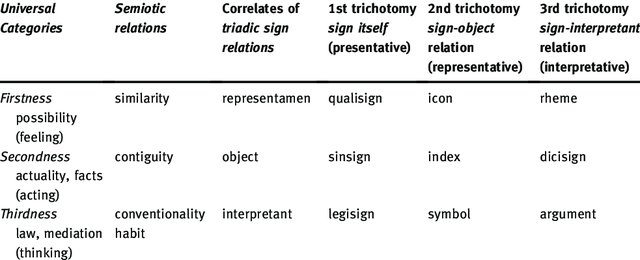Beyond Luhmann - Cybersemiotics
The central idea of autopoiesis in second-order cybernetics put forward by Von Foerster, Maturana and Varela was an important step for understanding the dymamics of cognition and communication in living creatures. Luhmann stretched the second-order cybernetics concept in the domain of social systems. This provided a strong foundation for understanding the complexities of such systems. However, some aspects in Luhmann's theory are less developed, most notably the concept of what makes a human being human, such as emotions, and the concepts of meaning and signs.
The latter two concepts - meaning and signs - requires some explanation. The theory of meaning and signs - semiotics - was amongst others established by C.S. Peirce. A sign is defined as: something which stands to somebody for something on some respect or capacity. Or simply put, a sign is something that evokes something for someone. Note that there are three elements involved: sign, object, and interpretant. A sign points to an object and produces another sign in the mind of an interpreter, i.e., the interpretant. The interpretant can be seen as interpretation of the original sign, that is, an equivalent or perhaps a more developed sign. This is the triadic (threefold) structure of semiosis - the process of meaning making. The three elements are all required, without any of them, there is no possibility for semiosis.
The triadic structure is a recurring part of Peirce's theory. He constructs categories comprised of three elements: firstness, secondness and thirdness, corresponding with feeling, acting and thinking, respectively as shown in the table below taken from Peirce’s universal categories (Irene Mittelberg, 1 maart 2019).
The structure of firstness, secondness and thirdness are applied to three elements sign, object, interpretant, which in their turn are structured according the triadic structure. It is beyond the scope of this writing to examine all triadic structures in detail (see Peirce's Theory of Signs for a thorough account). To give a flavor, consider the first trichotomy: the sign itself, or the presentative:
- qualisign: qualities that act as signs, for instance, the color red;
- sinsigns, actual instantiations of signs, for instance, a light that turns red;
- ligisigns, meaningful signs derived form convention, habit or law, for instance, a red traffic light that signals to drivers to stop.
The reflexive, self-referential nature of Peirce's semiotics, especially reflected in the thirdness, bears a strong resemblance to second-order cybernetics. Spencer-Brown developed in his Laws of Form a three-valued system. Besides the marked and unmarked state, a third boundary state was introduced that encompasses the notion of self-producing (autopoiesis) using its own elements. In the realm second-order cybernetics and Luhmann's social systems this means that living creatures reproduce themselves, not only in the physical sense (e.g., a cell that produces another similar one), but also in the form of action and reaction of autonomous observers based on past, self-referential experiences. The interpretant, or (more developed) signs, of the interpreter give meaning to the experiences as a result of interaction with objects, including human beings.
Semiosis is not restricted to verbal and visible communications between human beings. It involves all senses and emotions. The study of semiotics in living creatures is called biosemiotics. The addition of biosemiotics to second-order cybernetics and Luhmann's communication theory. The result is an all encompassing theory termed cybersemiotics, a combination of (second-order) cybernetics and (bio)semiotics. A short introduction can be found in "From Second-order Cybernetics to Cybersemiotics (Søren Brier, 1 september 1996)". The definite account of cybersemiotics is "Cybersemiotics: Why Information Is Not Enough (Søren Brier, 13 augustus 2013)".

